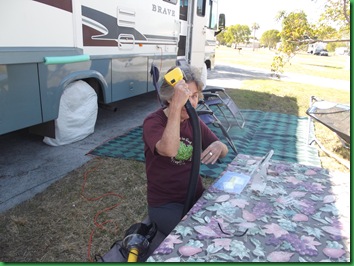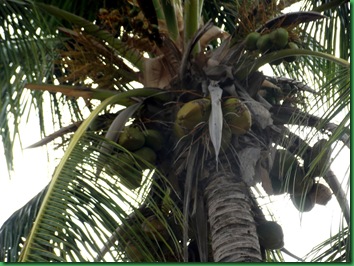Thursday February 7, 2013
Site T-15 Flamingo Campground
Everglades National Park
Well not exactly lost
We aren’t lost but we are totally out of touch. We left Midway at 11:00 on Sunday and drove the 106 miles all the way down to the very bottom of Everglades National Park where we heard for the very first time that the only cell phone or internet was AT&T. We have Verizon.
It is over 40 miles back from here to internet or cell service from Verizon. There is an 800 phone at the ranger station meaning that if you have a calling card or a service like One Suite, you can use their phone to make long distance calls. Luckily we do have one suite for just that sort of thing.
But on Thursday we will be making that trip for lots of reasons but we’ll get to those on Thursday. For now here’s how we have spent our first three days in Flamingo.
SUNDAY February 3
My advice is DO come to Flamingo and decide ahead of time whether you care to be connected. If you have AT&T then no problem but if like us and most folks I know, you have Verizon, you are out of luck.
So, if you come to Flamingo and want to stay in touch, get a cheap AT&T trac phone and some sort of AT&T air card. They have a tower here but they aren’t sharing.
Or you can do as we are doing and use a phone card and do without internet.
Flamingo Campground is at the very end of the road. We are all set up in site T15 where we have electric but had to take on water. This loop also has a dump site.
We get information on the ranger programs, hikes and kayak trails in this area from the National Register of Historic Places 1950’s Visitor Center. Makes me feel really old to hear that something built in my childhood is on the national register of HISTORIC places. Good grief. Am I historic too??
We checked with the marina to see if any of the mail we had sent here had arrived. The answer: not yet. But I got this great “fishing hat” with one of those trailing tails. Now I can cut my hair without worrying about getting a sunburned neck. It even has this cool little metal clip to affix to your shirt so in a strong wind, the hat won’t be lost if it blows off your head. Cool hat!!
MONDAY February 4
This morning I go out for a run around the campgrounds and find the solar heated showers. Very cool!! I chat with a woman named Sandy who tent camps every winter in Florida and every summer in Minnesota. She was in the restroom charging up her cell phone and her tablet. Guess she has AT&T. :-) She advised to take your shower in the afternoon if you want hot water.
We have breakfast outside in the fabulous weather after which I do cut my hair. But I don’t think to get a picture until I’m nearly finished. Love my flowbee.
Finished, for now.Then
I spend some quality time bonding with my hammock. Check out that really terrific mahogany tree in our extended acreage. They are native down here.
We take care of some set up and fix it things including getting out the little screened room we have in case the no seeums get too bad. So far so good.
Seriously laid back day.
One of the non electric loops in the campground near the amphitheater is right on the water. They can see the sunrise from their front doors. I’ll bike over tomorrow to see it.
Tonight we go looking for a spot to see the sun set. We are down on the tip of Florida after all. But alas there are just too many mangroves looking west.
Here we are on the trail hunting for a water view.
But the closer we get, the more the color fades and the more obscured our view becomes. Guess we’ll ask the rangers for some advice tomorrow but I’m thinking West is not a good direction for this end of the park.
Tuesday February 5
This morning I am up and out at 6:00 to see the dawn over Florida Bay.
What a GREAT idea.
I come back for a quick breakfast and am off to the 8am morning bird walk. David is just getting up.
We see over 30 different birds on the hike including the Prairie and Palm warblers, blue gray gnatcatchers, phoebes – all to fast for a camera.
But these two were my favorites of those I could get pictures of.
The red shouldered hawk
and the painted bunting. Both local residents.
On my way home I stop by the marina where I’ve heard some crocodiles hang out and sure enough. They are back in a corner hanging out but I get one shot of them. Boy they really don’t look like alligators. That was definitely a croc that Captain Hook was worried about.
After lunch I return to the visitor center for the “tropical trees” talk. David does too. The ranger discusses the 3 types of mangrove trees, the West Indian Mahogany and the 5 types of palms found in the park. In order to be considered “native” these trees have to have been here prior to Columbus.
We learn that the red mangrove is the “walking one”. It puts down roots every chance it can and looks like it is standing on its toes. I didn’t get the right kind of pictures to really explain this well. I took mostly leaf pictures since at this point I am very familiar with mangroves.
Sorry about that.
The black and white have the more common central trunk and are much better at shedding salt. The black even has little grains of salt on its leaves where it expels the salt picked up from the water. You can feel the grains when you touch the leaves.
She also showed a strangler fig which has pretty much taken over the palm on which it started to grow. You can see the palm in the center if you look closely but all the major bark there is the strangler fig. It’s native, so it stays in the park regardless of whom it takes over.
She showed examples of all 5 types of palm which are growing right around the visitor’s center. The coconut palm is easy to recognize because of its fruits. It isn’t really native but there are a lot of them for obvious reasons. She tells us we are welcome to any coconuts which fall on the ground but you probably wouldn’t want to be under the tree when that happens.
The Royal Palm I’ve talked about before in a Big Cypress post. You can recognize it by smooth bark, very tall, green upper trunk and giant feather fronds up to 15’ long.
The Paurotis Palm grows in clumps and has thorns on the stems of its fronds.
The thatch palm has a very thin trunk and large fronds with big “palms” on them, short “fingers”. These are the ones that are/were used by Native Americans to “thatch” their roofs. When you look at the different fronds on these palms it is easy to see why.
The final palm is the state tree, the Cabbage Palm or Sabal Palm (pronounced sable). It is the palm you see EVERYWHERE and it never crossed my mind to take a special picture of it. Sorry. It’s the one the ranger tells us the strangler fig likes most to take over. Good thing there are lots of them. Although at Big Cypress the strangler was really after the biggest cypress trees.
I like to try to do the informative ranger talks at the beginning of my time in a park so that I can know where I am better. This talk was excellent in helping my eyes to see the differences in the palms and the mangroves.


















Very interesting. I like those ranger talks/walks too.
ReplyDeleteI loved your sunset pics.... The trees added a lot of dimension and interest to the pics. That was one gnarly ole croc!! Were you using your zoom!! The ranger lead walks always add so much information and history they are well worth the time. Don't stay too long in one spot. They will add you to the Historic Register with a sign!!!
ReplyDeletelike that 'bunting' this year Hallmark used it as an ornament in their bird collection.. now, I have seen a REAL ONE!!! LIKED THE PICTURE OF THE WOODY WOODPECKER TOO, YOU TOOK THE OTHER DAY, THaT WAS GREAT!!!! You see lots of birds there. what do the vultures do to the cars???? wondered where u guys were, had not heard from you in ages :) take care, can see u are having a great time!!!
ReplyDeleteBeautiful sunrise pictures and I learned a lot I did not know about mangroves and palms from this blog! The painted bunting is a beautiful bird! Nice haircut ;)
ReplyDeleteI'm not sure I can be without internet (how sad is that!) I would love to go to that area..
ReplyDeleteI'm with Laurie -- we'd have some major withdrawal symptoms with no internet.
ReplyDeleteInteresting post. Love the painted bunting -- so pretty.
I'd have trouble without internet as well, but those Painted Buntings may just make a trip worthwhile!
ReplyDeleteHey....you're very close to the Keys (waterwise)...why don't you paddle over?